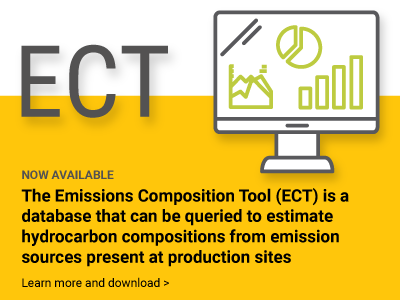Publications
Potential Underestimate in Reported Bottom-up Methane Emissions from Oil and Gas Operations in the Delaware Basin
February 2024 | Atmosphere
Featured as the cover story of Atmosphere’s February 2024 issue, this research paper is a comprehensive analysis of the potential systematic underestimates in current bottom-up methodologies for emissions inventories. Led by Colorado State University and supported by CAMS, the study investigated how emissions estimates could be improved by updating emission factors to consider regional variation and identified the largest sources of uncertainty in bottom-up emission inventories from oil and gas production.
This was accomplished by comparing measurements data from the Delaware basin to bottom-up inventories using current EPA and updated region-based emission factors. The study found EPA emission factors to underestimate emissions from the region and attributed the major sources of uncertainty to large fugitive emissions from oil and gas production, maintenance activity emissions, flaring inefficiencies, and associated gas venting. Based on these findings, the researchers assert that realistic emission factors can only be derived by accounting for the long tail distribution of oil and gas emissions and should be validated through direct comparison against measurement campaigns.
Assessing Detection Efficiencies for Continuous Methane Emission Monitoring Systems at Oil and Gas Production Sites
2022 | ChemRxiv
A pre-print in ChemRxiv that provides a framework for evaluating the detection efficiency of continuous sensor networks, using a network of fixed methane sensing systems deployed in the Permian Basin. The analysis framework described in this work can be applied broadly in the evaluation of continuous emission monitoring network designs. Results from the study suggest that while continuously operating fixed sensors will not detect all emissions, detection efficiencies are greater overall for continuous monitoring networks than for periodic short duration measurements.
Observations from Space: Exploring the Landscape of Current and Emerging Technologies to Identify and Quantify Methane Emissions Using Satellites
SEPTEMBER 2022
This Scientific Insights article highlights the emerging capabilities for satellite observations to anchor a global methane monitoring system that can deliver information worldwide in near real time, from the global scale down to point sources. These capabilities will become increasingly pivotal in verification and in supporting proliferating climate policies, regulations, and rules for corrective action.
Total Methane and CO2 Emissions from Liquefied Natural Gas Carrier Ships: The First Primary Measurements
JUNE 2022 | Journal of Environmental Science & Technology
A peer-reviewed publication by Queen Mary University of London researchers presents the results of the first-ever study measuring and modeling total methane and carbon dioxide (CO2) emissions from an LNG carrier ship on a round trip voyage from the United States to Belgium. The study is makes important strides towards improving our understanding of natural gas supply chain emissions. Results from the study show that CO2 emissions were substantially lower than previous estimates, but methane slip was higher, particularly from generator engines.
Quantifying Methane Emissions from the Global Scale Down to Point Sources Using Satellite Observations of Atmospheric Methane
APRIL 2022 | Atmospheric Chemistry and Physics
A pre-print in the ACP journal that reviews the capabilities of current and planned satellite observations to quantify methane emissions from the global scale down to point sources. The past few years have brought forth new satellite instruments for measuring atmospheric methane and new capabilities for detecting methane point sources from space, and new satellite instruments and capabilities are expected in the next few years. Motivated by these new developments, the review covers retrieval methods, precision and accuracy requirements, inverse methods for inferring emissions, source detection thresholds, and observing system completeness.
Field Inter-Comparison of Low-Cost Sensors for Monitoring Methane Emissions from Oil And Gas Production Operations
MARCH 2022 | Atmospheric Measurement Techniques
A pre-print in the AMT journal that presents findings from a new field study showing that multiple commercially available sensing systems are suitable for long term methane emission monitoring in remote oil and gas production. To conduct the study, researchers at the University of Texas tested four solar-powered methane sensing systems with remote communication capabilities at an oil and gas production site in west Texas over a nine-month period. Funding for this research was provided by CAMS, Environmental Defense Fund, ExxonMobil, Pioneer Natural Resources, and AT&T.
A Methane Emission Estimation Tool (MEET) for Predictions of Emissions from Upstream Oil and Gas Well Sites with Fine Scale Temporal and Spatial Resolution: Model Structure and Applications
MARCH 2022 | Science of the Total Environment
A peer-reviewed article by University of Texas researchers in press by the journal Science of the Total Environment presents the capabilities of MEET as a tool for estimating routine emissions from oil and gas well sites at multiple time scales. Additional work describes MEET’s capabilities for gathering and compression stations and MEET’s capabilities for estimating emission composition. MEET is a modular model and is freely available to the public. Funding to perform this work was provided by CAMS.
Modeling Air Emissions from Complex Facilities at Detailed Temporal and Spatial Resolution: The Methane Emission Estimation Tool (MEET)
FEBRUARY 2022 | Science of the Total Environment
A peer-reviewed article by University of Texas researchers in press by the journal Science of the Total Environment shows how the landmark Methane Emission Estimation Tool can be used to model temporally and spatially resolved inventory emissions at compressor station emissions – the key facility type in midstream natural gas operations. Funding to perform this work was provided by CAMS.
Permian Basin Survey: An array of aerial surveys in the Permian Basin to acquire the baseline distribution of methane emission rates and sources
AUGUST 2021
A Scientific Insights article highlights results from a study aimed at identifying and statistically analyzing leaks and leak rates in the Permian Basin by type of equipment. Read the CAMS white paper to learn more about the results and efforts to assess capabilities of an airborne LiDAR technology for detecting and quantifying methane leaks in the Permian.
The Methane Emission Estimation Tool: A Model for Developing Fine Scale Spatial and Temporal Methane Emission Estimates for Oil and Gas Basins
JUNE 2021
A Scientific Insights article describes the Methane Emission Estimation Tool (MEET), a community modeling tool developed with the support of CAMS by researchers at the University of Texas and Colorado State University for constructing inventories of methane emissions from oil and gas operations.
A Searchable Database for Prediction of Emission Compositions from Upstream Oil and Gas Sources
FEBRUARY 2021 | Environmental Science & Technology
A peer-reviewed article by University of Texas researchers published in Environmental Science & Technology (ES&T) presents a database tool that can be used to estimate emissions compositions at oil and gas production sites. Funding to perform this work was provided by CAMS.


